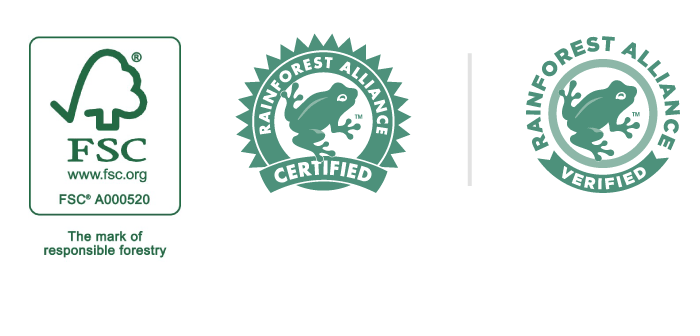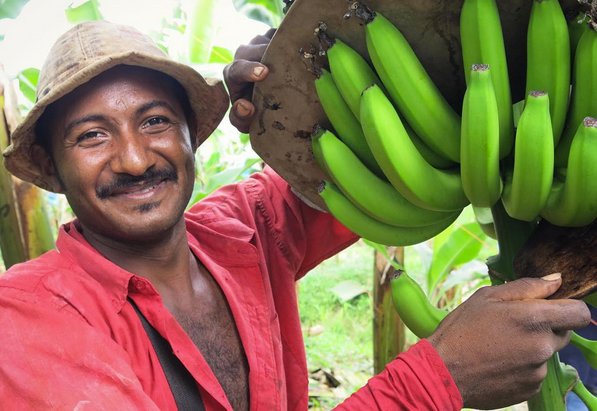Rainforests hold earth’s most complex and diverse ecosystem and help us to live and breathe. Due to (mostly) unconscious deforestation, they are disappearing and so is the life and wisdom within. How can we protect and preserve the ‘lungs of the earth’?
This post was originally shared in 2016 but has been updated.
Named because of between 250 and 450 centimetres of rainfall each year, rainforests are found near the equator in South and Central America, Asia, Africa and Australia. Over 50% of the world’s animals and plants are currently found living there, including over 2,000 plants edible to humans – such as pineapples, coffee, cacao bananas, acai, avocados, cinnamon and palm oil.
Within the many intricate layers of the jungle live indigenous tribes that live close to, carry and protect the jungle’s ancient wisdom. Sadly a lot of these tribes are forced out of their homes and are becoming extinct, due to deforestation. The below photo is of a highlander from the island of New Guinea, where there are almost 1,000 different tribal groups (photo from the Rainforest Alliance instagram).
Medicines and cures for human diseases and ailments are also found in rainforests (more than 70% of plants that have anti-cancer properties are found there) and animals that cannot exist anywhere else on our planet, live in the jungle. Due to deforestation, many of the animals are now endangered species, like the sumatran tiger and orangutan.
Called the lungs of the earth, rainforests recycle carbon into oxygen so that we can – collectively – live and breathe. In 1950 they covered around 15% of our planet, now they cover around 6% and are diminishing each year due to deforestation.
Global Warming is real, is happening and it effects us all. Carbon dioxide emissions have reached extremely dangerous levels on earth due to activities like burning of fossil fuels (like coal, oil and natural gas), cement production and deforestation.
With every tree cut, animals die and lose their homes. We are killing the rainforests and everything inside and, in turn, we are killing ourselves.
According to the Rainforest Alliance, around 13 million hectares of forests were lost globally, each year between 2000 and 2010. The figure is now said to have gone up to 15 million hectares destroyed annually. If it continues like this, there will be no rainforests in 50 years. As rainforests are destroyed, the plants and trees release more carbon dioxide into the air, which contributes further to the Global Warming of our planet. The earth is overpopulated and people are uneducated on how to ensure the survival of this beautiful planet and the species that live here.
We need to individually and collectively help to regain earth’s natural balance and respect its natural resources and wisdom.
How are the rainforests being destroyed?
The below is taken from: Rainforestconcern.org
Cattle ranching:
Many rainforests in Central and South America have been burnt down to make way for cattle farming, which supplies cheap beef to North America, China and Russia. It is estimated that for each pound of beef produced, 200 square feet of rainforest is destroyed. In the past 20 years Costa Rica has lost the majority of its forests to beef cattle ranching. This is known as slash and burn farming and is believed to account for 50% of rainforest destruction. However, the land cannot be used for long: the soil is of poor quality and, without the forest, quickly becomes very dry. The grass often dies after only a few years and the land becomes a crusty desert. The cattle farmers then have to move on and destroy more rainforest to create new cattle pastures. Indigenous Indians also use “slash and burn” farming techniques, but on a small scale. For centuries they have used a sustainable system where, when they finish using one small patch of land, they move away to a different area and allow the forest to regenerate. Since the area cleared is small, the soil does not dry out and therefore the forest clearance is localized and temporary rather than extensive and permanent.
Logging:
This is believed to be the second largest cause of deforestation. Timber companies cut down huge trees such as mahogany and teak and sell them to other countries to make furniture. Smaller trees are often used for the production of charcoal. Vast areas of rainforest are cut in one go (clear felling) and the most valuable trees are selected for timber, leaving the others for wood chipping. The roads that are created in order to cut and remove the timber often lead to further damage: see the effect of forest roads under “Oil Companies”.
Agriculture:
Much of the fruit, cereals and pulses we buy from tropical countries have been grown in areas where tropical rainforests once thrived. The forests are cut down to make way for vast plantations where products such as bananas, palm oil, pineapple, sugar cane, tea and coffee are grown. As with cattle ranching, the soil will not sustain crops for long, and after a few years the farmers have to cut down more rainforest for new plantations.
Mining:
The developed nations relentlessly demand minerals and metals such as diamonds, oil, aluminium, copper and gold, which are often found in the ground below rainforests. The rainforests therefore have to be removed in order to extract them. Poisonous chemicals are sometimes used to separate the waste from the minerals, for example mercury, which is used to separate gold from the soil and debris with which it is mixed. These chemicals often find their way into rivers, polluting water supplies which local people depend on, killing fish and other animals that feed on them.
Oil Companies:
Rainforests are seriously affected by oil companies searching for new oil deposits. This is incredibly damaging as often large roads are built through untouched forests in order to build pipelines and extract the oil. This encourages settlers to move into hitherto pristine forests and start slash-and-burn farming or cutting more timber for sale or the production of charcoal. Once established, the oil pipelines which transport the oil often rupture, spouting gallons of oil into the surrounding forest, killing wildlife and contaminating the water supplies of local villages.
Dams:
The World Bank and large companies invest money in developing countries to build dams for the generation of electricity. This can involve flooding vast areas of rainforest. Dams built in rainforest areas often have a short life because the submerged forest gradually rots, making the reservoir water acidic, which eventually corrodes the dam turbines. The dams can also become blocked with soil washed down from deforested highlands in heavy rains. This can cause great problems, such as flooding.
How can we help?
Donate – here are a list of causes:
http://www.rainforest-alliance.org/
http://www.rainforestfoundation.org
https://www.rainforesttrust.org/
http://www.greenpeace.org.uk/amazon
http://www.survivalinternational.org
Palm oil is said to be one of the worst culprits of agriculture – http://www.saynotopalmoil.com has more in-depth knowledge. A lot of foods and household products contain palm oil so ALWAYS READ THE LABEL and check it is sustainable.
Pineapples, cacao, coffee, acai, avocados, bananas and much more come from rainforests. Buy eco friendly products that support local farming and local communities. A trusted source is Rainforest Alliance certified products. Buy products with the below stamp from http://www.rainforest-alliance.org/
According to the rainforest alliance: “Sustainable agriculture is going to play a huge role in feeding the 9 billion people who will inhabit our planet by 2050 and we are proud to be working on solutions so that people and the planet can prosper together.”
Ask questions, learn, teach – Where does what you consume come from? How was it made? Look at what you currently consume – inside your body, on your body and in your living situation. Consumer creates demand, so when you change, the market will change.
Don’t eat meat, or if you have to, choose meat or leather goods that comes from animals that have been raised and slaughtered sustainably (as much as they can be…).
Buy second hand wood furniture, or, buy from a source you know uses sustainable timber.
Reuse and Recycle
Spread awareness. Think what would work best in your community / tribe. Trust your voice. Use your voice.
Plant a rainforest and support rainforest tribes: www.goodgifts.org - for ideas like this and more.
Volunteer in the rainforest: The Rainforest Concern has a list here
Use eco-friendly Renewable Energy sources alternative to fossil fuels:
*Solar power
*Wind power
*Ocean power
*Geo thermal power
* Renewable Energy sources are less expensive that you think – check this piece on the Huffington Post
Invest in eco-tourism for your holiday – visit the rainforests; live and learn about their gifts to the planet – check http://www.rainforest-alliance.org/work/tourism – here you can find out how to travel sustainably and it also answers questions such as the difference between eco-tourism, sustainable tourism and nature tourism.
It is so easy to forget about something that is so far away, as it feels it doesn’t connect to us, but, think of the butterfly effect – every action has a reaction; every deed, thought and action counts and we all have the power to make changes. The beauty of earth is the diversity and how every aspect is somehow connected and works in a magical synergy so that we all may live and breathe.
We have to heal, preserve and protect this beautiful planet we live on, and support her as she supports us.
This post was written by Kim Booth





